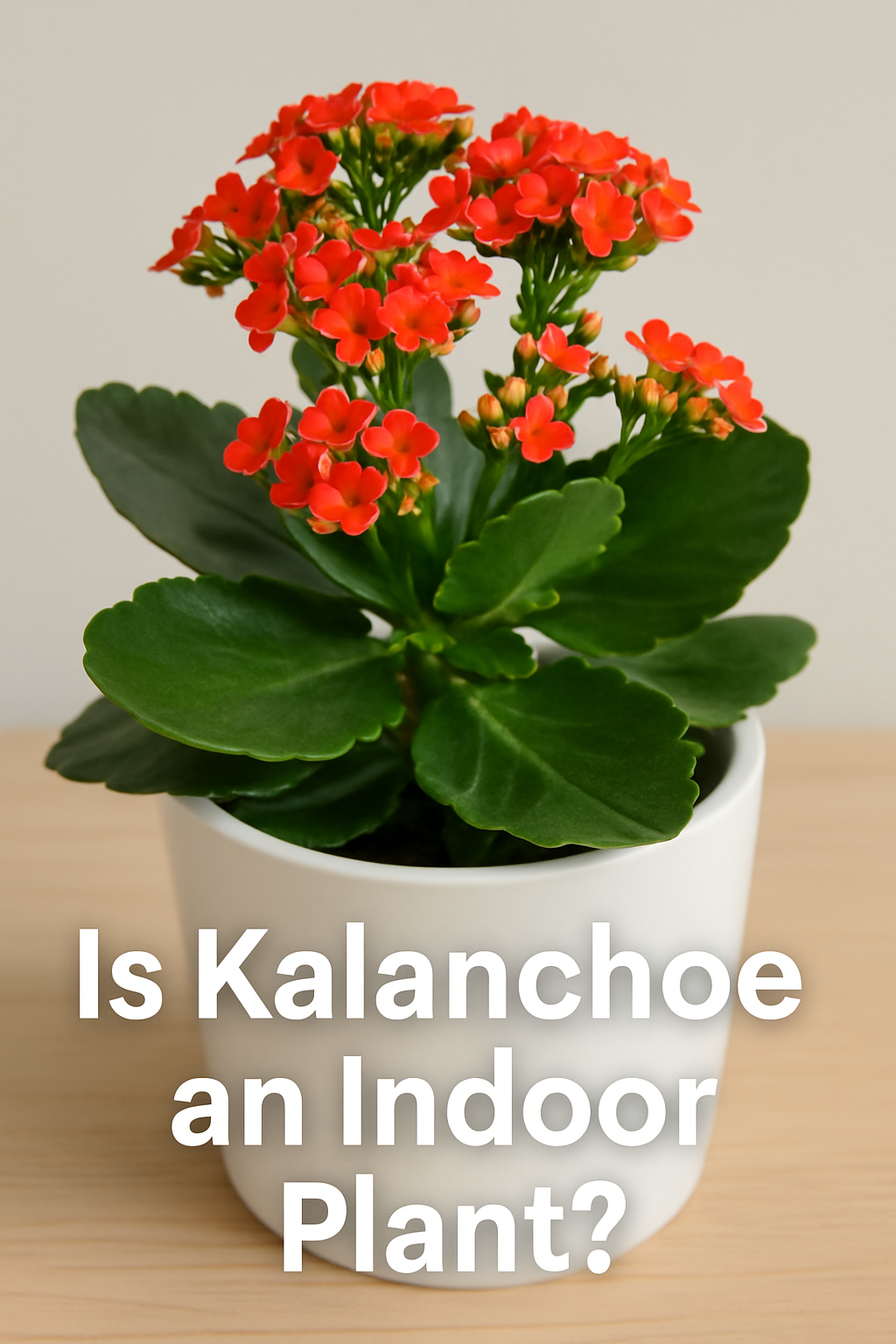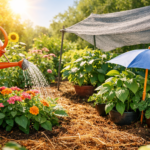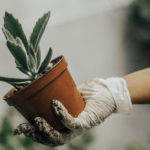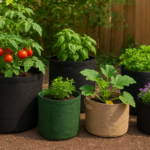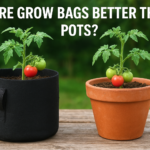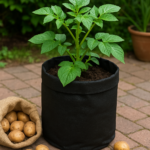Kalanchoe plants belong to the Crassulaceae family and are known for their thick, fleshy leaves and bright, cheerful flowers. Originating from tropical and subtropical regions, they are naturally adapted to store water, making them ideal for low-maintenance gardening. Many people recognize kalanchoe as a “holiday plant” because it often blooms around winter and early spring, bringing color to homes when other plants are dormant. But beyond their seasonal beauty, kalanchoes are year-round houseplants that can thrive indoors with just a few basic care steps.
These plants are available in a variety of species and cultivars, offering options from compact flowering types to more sculptural foliage plants. Their flowers can last for weeks, and their foliage stays attractive even when not in bloom. In interior design, kalanchoe is often used as a table centerpiece, windowsill decoration, or part of a mixed indoor succulent arrangement.
What are Kalanchoe Plants?

Kalanchoe is one of the most versatile plants you can grow, and the short answer is yes — it makes an excellent indoor plant. These vibrant, low-maintenance succulents are famous for their long-lasting blooms, easy care, and ability to thrive in small pots. Unlike many flowering plants, kalanchoes don’t require excessive attention, making them perfect for busy homeowners or plant beginners. Their thick, fleshy leaves store water, allowing them to survive occasional neglect, while their colorful blooms add a cheerful touch to any room.
Origin and Natural Habitat of Kalanchoe
Kalanchoe plants are native to Madagascar and parts of Africa, with some species also found in Asia. In their natural environment, they grow in rocky, well-drained soils under bright, indirect sunlight. These regions often have long dry seasons, so kalanchoes evolved to store water in their leaves and stems. This adaptation makes them drought-tolerant and well-suited for indoor conditions where humidity may be low and water availability inconsistent.
In the wild, kalanchoes grow in open areas exposed to plenty of light but protected from harsh direct sun for long periods. They flourish in climates where temperatures stay warm year-round, which is why they don’t naturally survive freezing winters without protection. Their natural habitat provides a clue to how they should be cared for indoors — bright light, moderate temperatures, and minimal watering.
Is Kalanchoe an Indoor Plant?

Yes, kalanchoe is an excellent indoor plant, loved for its vibrant blooms, low maintenance, and adaptability to household conditions. Native to Madagascar, kalanchoe thrives in bright, indirect light and prefers warm temperatures. Its thick, fleshy leaves store water, making it drought-tolerant and ideal for busy or beginner plant owners. Indoors, it can bloom for up to eight weeks and, with proper care, flower multiple times a year.
Kalanchoe requires well-draining soil, occasional watering when the topsoil is dry, and light feeding during its growing season. Overwatering should be avoided, as it can lead to root rot. Compact in size, it fits easily on windowsills, desks, or tables, adding long-lasting color and charm.
Why Kalanchoe Makes a Great Indoor Plant
Kalanchoe has earned its spot as one of the best indoor plants for several reasons. First, it thrives in typical household temperatures and humidity levels, making it adaptable to most living spaces without special equipment. Second, its low-water needs mean less maintenance compared to thirsty plants like ferns or tropical flowers. You won’t need to water it daily — in fact, overwatering is the most common cause of problems.
Another big advantage is its long-lasting blooms. Unlike many flowering plants that bloom for just a few days, kalanchoe flowers can last up to eight weeks indoors. And with proper care, you can encourage them to bloom multiple times a year. This makes them a great choice for adding consistent color to your home without constantly replacing plants.
Types of Kalanchoe Suitable for Indoors
There are over 200 species of kalanchoe, but not all are suited for indoor growth. The following are the most popular types you’ll see in homes and offices:
Kalanchoe blossfeldiana
The most widely grown indoor kalanchoe, Kalanchoe blossfeldiana is known for its bright flower clusters in shades of red, orange, pink, yellow, and white. This variety blooms in winter and early spring, often sold around holidays. It grows up to 12 inches tall, thrives in bright light, and needs only occasional watering.
Kalanchoe tomentosa (Panda Plant)
This is a foliage kalanchoe with thick, fuzzy, gray-green leaves tipped in brown. It’s loved for its soft texture and ornamental appeal. Panda plants don’t bloom often indoors but are prized for their year-round beauty and low maintenance.
Kalanchoe pinnata (Cathedral Bells)
Also called the “miracle leaf” plant, this kalanchoe has medicinal uses in some cultures. It has broad, scalloped leaves and can grow taller than most indoor kalanchoes. It prefers bright, indirect light and occasional pruning to maintain shape indoors.
Light Requirements for Indoor Kalanchoe
Light is one of the most important factors for a healthy indoor kalanchoe. It thrives in bright, indirect sunlight and can also handle some direct morning or late afternoon sun. A south- or west-facing window is ideal. Without enough light, kalanchoe will grow leggy and may not bloom.
If natural light is limited, a grow light can help maintain its health and flowering cycle. Aim for 10–12 hours of light exposure daily. Remember, too much harsh direct sunlight can scorch the leaves, while too little will stunt growth.
Mimicking its natural bright habitat ensures kalanchoe stays compact, lush, and colorful indoors.
Ideal Temperature and Humidity Levels
Kalanchoe prefers warm indoor temperatures between 60°F and 85°F (15°C–29°C). It cannot tolerate frost, so keep it away from drafty windows in winter. Sudden temperature drops can cause leaves to wilt or flowers to fall prematurely.
Humidity is less of a concern, as kalanchoe thrives in low-humidity environments, just like in its native Madagascar. Average household humidity is usually perfect. Avoid placing it in overly damp rooms or near humidifiers, as excess moisture can lead to fungal issues.
A steady, warm environment with good airflow is the secret to year-round kalanchoe health indoors.
How to Water Kalanchoe Indoors?

As a succulent, Kalanchoe stores water in its leaves, meaning it prefers infrequent watering. Water deeply only when the top inch of soil feels dry, then allow excess water to drain out completely. Never let the plant sit in water, as this can cause root rot.
In winter, reduce watering further, as the plant’s growth slows. Always use a pot with drainage holes to prevent waterlogging. Overwatering is the most common cause of kalanchoe problems indoors, so it’s better to underwater slightly than to overwater.
Soil and Potting Tips for Indoor Growth
Kalanchoe needs well-draining soil to thrive indoors. A cactus or succulent potting mix works best. You can also mix regular potting soil with sand or perlite to improve drainage.
Choose a pot with drainage holes and avoid overly large pots, as kalanchoe prefers a snug root space. Repotting is usually needed every 2–3 years or when the plant outgrows its pot. This refreshes the soil and provides room for healthy root growth.
Fertilizing Your Indoor Kalanchoe
Fertilize kalanchoe every 4–6 weeks during its active growing season (spring and summer) using a balanced, water-soluble fertilizer diluted to half strength. Avoid over-fertilizing, as this can lead to excessive leafy growth and fewer blooms.
During fall and winter, reduce feeding, especially when the plant is blooming or resting. Proper feeding encourages vibrant flowers and healthy foliage year-round indoors.
Pruning and Maintenance for Healthy Growth
Pruning keeps your indoor kalanchoe looking tidy and promotes more blooms. After flowers fade, trim back the spent stems to encourage new growth. Remove any yellowing or damaged leaves to prevent disease spread.
Light pruning throughout the year helps maintain the plant’s shape, while heavier pruning after the blooming cycle can prepare it for the next round of flowers. Always use clean, sharp scissors or pruning shears to avoid plant damage.
Common Indoor Pests and How to Control Them
While kalanchoe is relatively pest-resistant, it can still attract mealybugs, aphids, and spider mites indoors. Regularly inspect the leaves and stems for signs of pests such as sticky residue, webbing, or small moving insects.
For light infestations, wipe the leaves with a damp cloth or spray with insecticidal soap. For heavier infestations, neem oil works as an effective natural solution. Always isolate an affected plant to prevent the pests from spreading to others indoors.
Blooming Indoors – How to Get More Flowers
Kalanchoe’s blooms are triggered by shorter daylight hours. To encourage more flowers, provide it with about 14 hours of darkness daily for 6 weeks, while keeping it in bright light the rest of the day.
Deadhead spent flowers promptly to redirect energy toward new blooms. Fertilizing lightly during the growing season also supports better flowering. With the right light cycle, kalanchoe can bloom multiple times indoors each year.
Common Problems with Indoor Kalanchoe and Solutions
Even though kalanchoe is considered a hardy and low-maintenance indoor plant, it can still face a few common issues. Recognizing these problems early and knowing how to fix them will keep your plant healthy and thriving.
- Overwatering & Root Rot:
One of the biggest mistakes with kalanchoe is overwatering. Too much moisture causes roots to rot, leading to drooping or mushy leaves. Solution: Allow the top 1–2 inches of soil to dry before watering again, and always use a pot with drainage holes. - Leggy Growth:
If your kalanchoe starts stretching out with long, weak stems, it’s a sign of insufficient light. Solution: Move the plant to a brighter location, preferably near a sunny window, or use a grow light for 10–12 hours daily. - Lack of Blooms:
Sometimes kalanchoe refuses to flower indoors due to inadequate darkness or poor feeding. Solution: Provide about 14 hours of darkness daily for 6 weeks before its blooming season, and use a balanced fertilizer during the growing months. - Pests:
Mealybugs, aphids, and spider mites can occasionally attack kalanchoe. Solution: Wipe leaves with a damp cloth, spray with insecticidal soap, or use neem oil.
Benefits of Keeping Kalanchoe as an Indoor Plant
Kalanchoe is more than just a pretty plant — it offers a variety of benefits that make it an excellent choice for any indoor space. Here’s why adding this succulent to your home or office can be a smart move:
- Long-Lasting Blooms: Unlike many indoor flowering plants, kalanchoe blooms can last up to eight weeks, bringing continuous color to your space. With proper care, it can flower multiple times a year.
- Low Maintenance: Its succulent nature means it stores water in its leaves, so you don’t have to water it often. This makes it perfect for busy lifestyles or beginner gardeners.
- Compact and Space-Saving: Its small size makes it ideal for desks, windowsills, shelves, or small apartments without taking up too much room.
- Air-Purifying Qualities: Like many houseplants, kalanchoe can help filter indoor air, making your environment fresher.
- Decorative Versatility: Available in various flower colors and leaf shapes, kalanchoe can match any décor style, from modern minimalism to cozy cottage aesthetics.
- Pest Resistance: Compared to other houseplants, kalanchoe is less prone to pests, reducing the need for constant monitoring.
Can Kalanchoe Be Grown Outdoors Too?
Yes, kalanchoe can also grow outdoors in warm, frost-free climates. However, in colder regions, it’s best grown indoors or brought inside during winter. Outdoors, it prefers partial sun, well-draining soil, and protection from heavy rain.
Many gardeners grow kalanchoe outdoors in summer, then move it indoors for winter flowering.
Final Care Checklist for Indoor Kalanchoe
Caring for a kalanchoe indoors is simple once you know its key needs. Here’s a detailed checklist you can follow to keep your plant healthy and blooming year-round:
- Light: Place in bright, indirect sunlight. A south- or west-facing window is ideal. Use a grow light if natural light is limited.
- Temperature: Maintain a warm environment between 60°F and 85°F (15°C–29°C). Avoid drafts, sudden temperature changes, and frost.
- Watering: Water only when the top 1–2 inches of soil are dry. Let excess water drain completely, and never let the pot sit in water.
- Soil: Use a well-draining succulent or cactus mix. Add perlite or sand if using regular potting soil.
- Fertilizing: Feed every 4–6 weeks in spring and summer with a diluted, balanced fertilizer. Reduce feeding in fall and winter.
- Pruning: Remove dead blooms and yellowing leaves to encourage fresh growth. Trim after flowering to shape the plant.
- Pests: Check regularly for mealybugs, aphids, or spider mites. Treat early with insecticidal soap or neem oil.
- Bloom Encouragement: Provide shorter daylight hours (about 14 hours of darkness) for 6 weeks to trigger blooming cycles.
Conclusion
Kalanchoe is one of the best flowering succulents for indoor life. Its colorful blooms, easy care needs, and resilience make it a perfect addition to homes and offices. With proper light, watering, and seasonal maintenance, kalanchoe can reward you with months of beauty year after year.
FAQs
1. How long do kalanchoe flowers last indoors?
Up to 8 weeks with proper care.
2. Is kalanchoe toxic to pets?
Yes, it can be toxic to cats and dogs if ingested.
3. Can kalanchoe grow in low light?
It will survive but may not bloom well.
4. How often should I repot kalanchoe?
Every 2–3 years or when roots outgrow the pot.
5. Can I propagate kalanchoe indoors?
Yes, from leaf or stem cuttings in well-draining soil.

